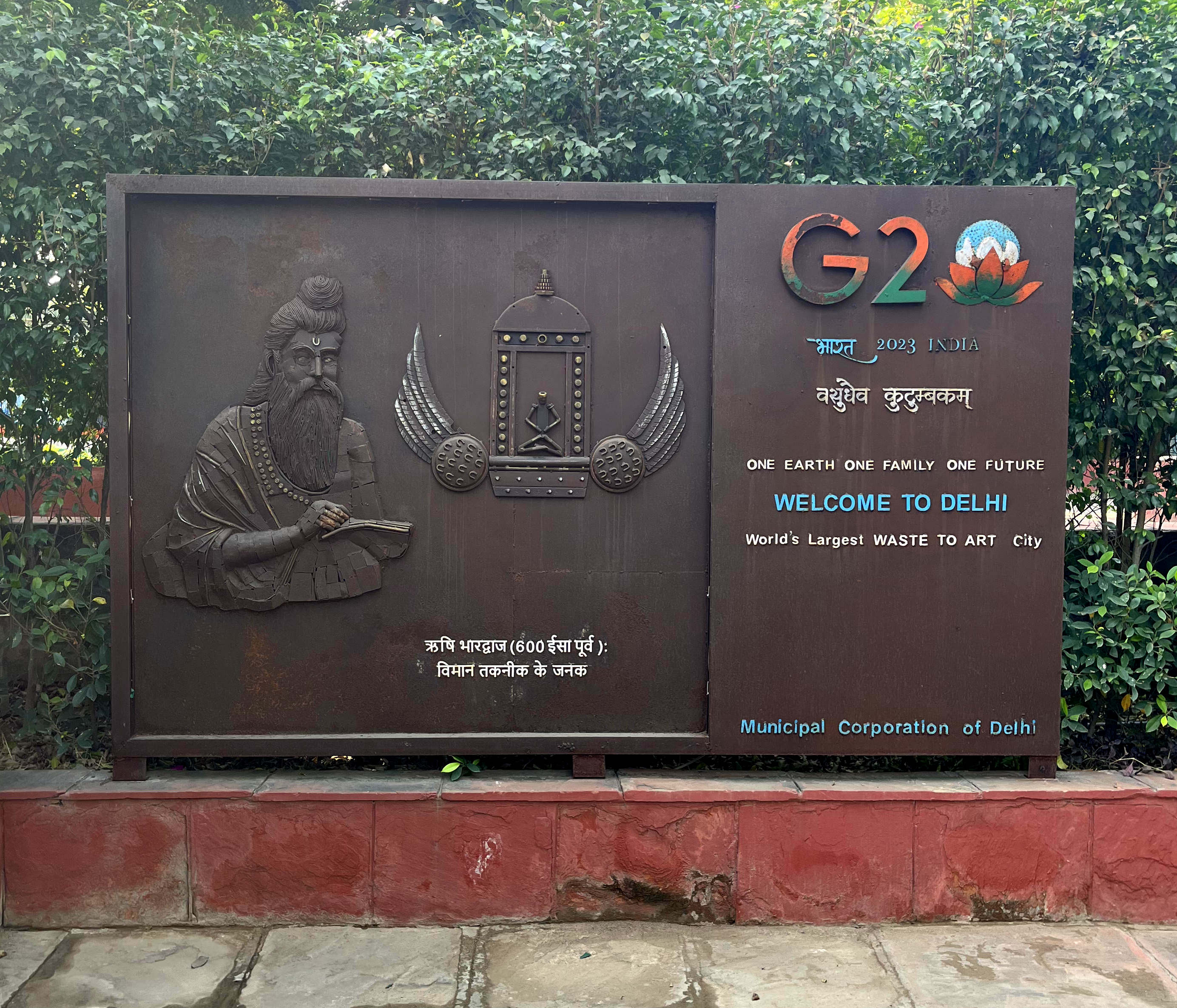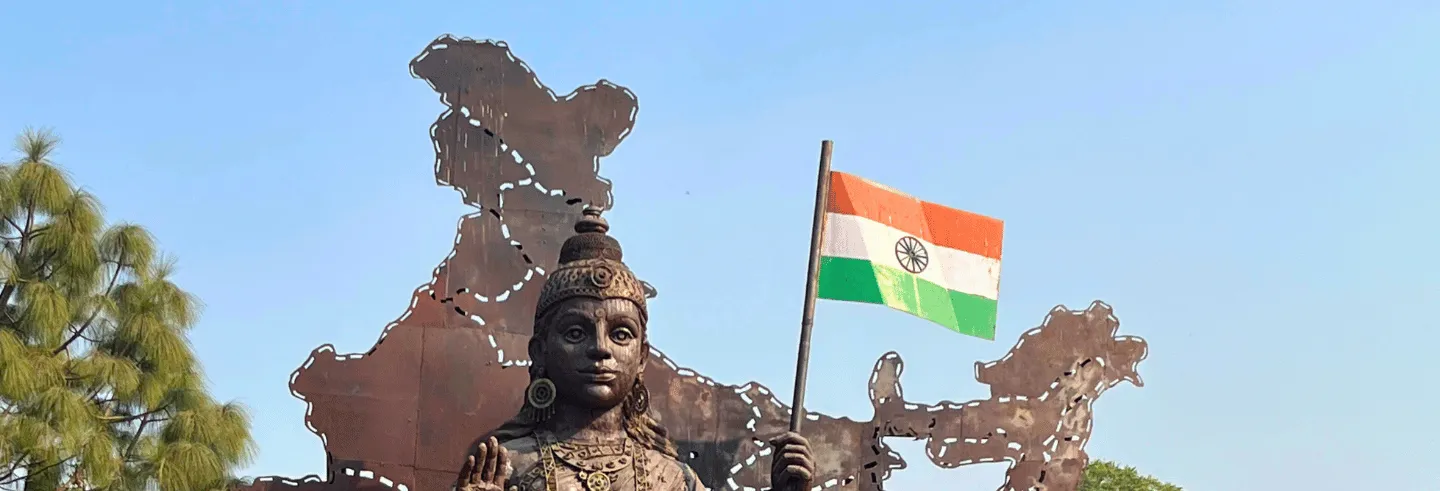Soon after India's first outdoor museum opened in Delhi’s Shaheedi Park in 2023, it made its way into lists of the city’s 'must-see' sites. The park’s paved pathways, lined with shrubs and trees and the soothing water of its fountains, offered a reprieve from Delhi’s heat, dust, noise, and crowds. Once inside, visitors could admire larger-than-life reliefs, sculptures, and installations of historical figures, all cast from metal salvaged from scrap.
The museum’s use of scavenged metal waste from the city might proclaim itself as a symbol of an urban future rooted in sustainable development. In reality, the making of the museum usurps the park’s function as a civic space for community use and political activism, to produce a curated environment aimed at crafting a narrow national identity.
Enclosing the Commons
The foundation stone for Shaheedi Park was laid in 1994 by Atal Bihari Vajpayee, then the leader of the opposition in Parliament. In 2001, Vajpayee returned to the park, this time as prime minister, to unveil statues of Bhagat Singh, Shivaram Rajguru, and Sukhdeo Thapar. Installed in the centre of the park, the statues memorialised the contributions of the three young revolutionaries hanged by the British Indian government in 1931 for their involvement in the Lahore Conspiracy Case.
For several years, Shaheedi Park functioned as a maidan for the community: children played in it, locals and migrants sought out the space for moments of leisure and rest, and petty vendors plied their wares. On occasion, it was the venue for political gatherings, due to the open space and the park’s association with the revolutionaries. In 2017, after a ban on demonstrations at Jantar Mantar—until then the designated site for protests—the All India Kisan Sabha, the farmers’ wing of the Communist Party of India (Marxist), occupied Shaheedi Park to demand support for the farm sector. In 2019, hundreds of women swarmed the park to oppose the Citizenship Amendment Act.
Shaheedi Park leans towards a nativist idea of nationalism that relies on otherisation to reinforce a singular, exclusionary narrative of the nation.
This lively space of the maidan has now been enclosed in the museum, with entry now reserved for those who can afford to buy tickets. It has become a site of consumption, where leisure and recreation are to be had for a fee and are intertwined with the shaping of a narrow historical narrative and identity. What was once an open expanse, allowing people to gather for various purposes, has been reshaped into a tightly curated space featuring manicured green lawns, fountains, and round-the-clock security surveillance. Visitors cannot wander freely; they must follow the route indicated by the signage. The space is designed so as to discourage visitors from making their own choice of how they want to navigate the museum. The park's function as a civic space—one that welcomes social movements and permits political activities—now remains a distant possibility.
Curating the Nation
The idea of the new museum at Shaheedi Park came about in the run-up to the 2023 G20 Summit in Delhi, when several of the city’s parks and public monuments got makeovers to showcase India's heritage to the visiting delegations. At Shaheedi Park, it took the form of a homage: "dedicated to India’s national heroes, showcasing renowned personalities who sacrificed their lives at various points in history for the country’s independence and sovereignty". 1The text is from a billboard in the park.
Through its displays, the museum seeks to anchor the modern nation through its ancient past. The narrative begins with a brief account of the valour of the legendary king Bharat from the Mahabharata. At another point, ancient sages are presented as progenitors of modern scientific discoveries. The visitor moves through sections titled Indian Scientists, The Golden Age of India, The Maratha Empire, India’s First Struggle for Independence, The Non-Cooperation Movement, and Recipients of the Param Vir Chakra. Life-like representations elevate historical and legendary figures to a heroic and divine status. They encourage visitors to treat the figures and their biographies as objects of darshan, and see them as mahapurush (great souls) with divine and magical powers.

Although the museum’s curation includes Dalit and Bahujan figures like Bhim Rao Ambedkar and Jotiba Phule, as well as marginalised icons such as Birsa Munda and Rani Gaidinliu, there is a conspicuous absence of Muslim rulers. They are instead portrayed as foreign invaders, mirroring similar narratives and exclusions in school textbooks.
The iconography of most historical figures represented in the museum is framed through a masculine lens. Historical figures are depicted with muscular bodies, wielding swords and axes. Elsewhere, Anuradha Kapur and Rakhi Bose have commented on the physical transformation of icons of Ram and Hanuman, where earlier gentle depictions evolve into iconographies reflecting aggression, a development that quickens with the rise of Hindu nationalism in India. This trend has not spared even Samudragupta (c. 330-380 CE), the Gupta-period monarch who was famously depicted in his times as playing the veena; in Shaheedi Park, a courtier standing nearby proffers him an axe.
Art, Sustainability, and the Nation
The narrowness of Shaheedi Park’s vision is also visible in its execution of Waste to Art, the Delhi Municipal Corporation’s theme for renovating several of the city’s parks. Discarded items—such as old trucks, cars, electricity poles, pipes, and angle irons—have been used to build the sculptures and installations. The process of creating artwork from waste materials has been in vogue since the early 20th century, including by Marcel Duchamp (Fountain, 1917), Pablo Picasso (Bull's Head, 1942) and Subodh Gupta, to challenge notions of what constitutes art. Unlike these approaches that challenge conventions of academic realism, the metal heap in the Shaheedi Park museum has been used to reproduce conventional typologies of art, with no apparent innovation. The only claim the museum authorities rely on is that they are recycling waste. The curatorial intent ends there; the museum does not have a designated officer to use the theme of waste-to-art to develop and implement programmes for public awareness.
Mythology and epics are significant for a nation's cultural memory, but cannot be substituted as evidence of an objective historical reality, the historian Harbans Mukhia wrote nearly two decades ago. Oftentimes, he pointed out, such mythological narratives are brought to the forefront to galvanise people around political ideologies. The museum in Shaheedi Park serves a similar purpose, pushing a form of nationalism that is crafted to achieve a political goal. In the process, the complexity of the past has been disregarded, and the warning of historians such as Romila Thapar (1966) against a simplistic application of modern categories to describe the social context of ancient times has been cast aside. Shaheedi Park leans towards a nativist idea of nationalism that relies on otherisation to reinforce a singular, exclusionary narrative of the nation.
Akash Bharadwaj is a PhD candidate in the Department of History and Archaeology at Shiv Nadar University, Dadri, Uttar Pradesh.









